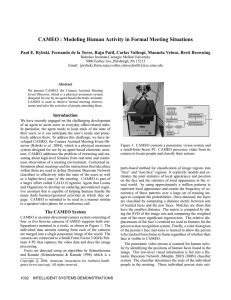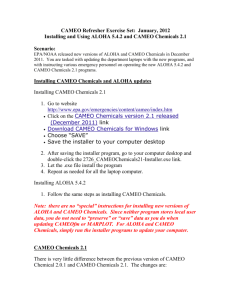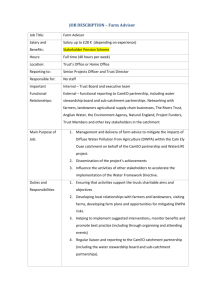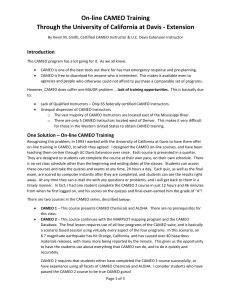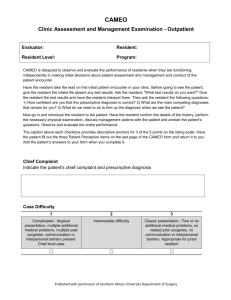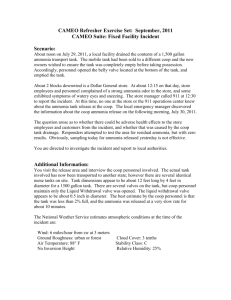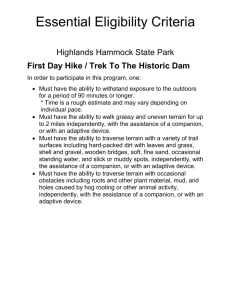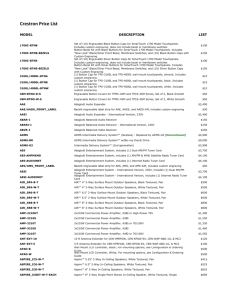CAMEO Fixed Facility Incident
advertisement
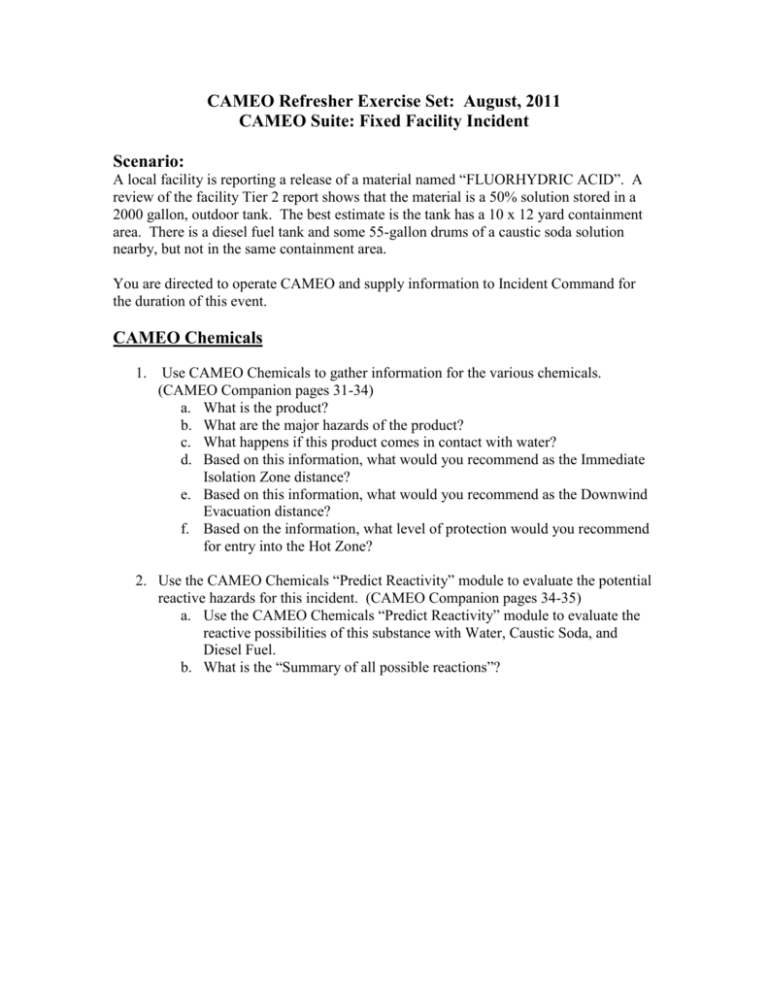
CAMEO Refresher Exercise Set: August, 2011 CAMEO Suite: Fixed Facility Incident Scenario: A local facility is reporting a release of a material named “FLUORHYDRIC ACID”. A review of the facility Tier 2 report shows that the material is a 50% solution stored in a 2000 gallon, outdoor tank. The best estimate is the tank has a 10 x 12 yard containment area. There is a diesel fuel tank and some 55-gallon drums of a caustic soda solution nearby, but not in the same containment area. You are directed to operate CAMEO and supply information to Incident Command for the duration of this event. CAMEO Chemicals 1. Use CAMEO Chemicals to gather information for the various chemicals. (CAMEO Companion pages 31-34) a. What is the product? b. What are the major hazards of the product? c. What happens if this product comes in contact with water? d. Based on this information, what would you recommend as the Immediate Isolation Zone distance? e. Based on this information, what would you recommend as the Downwind Evacuation distance? f. Based on the information, what level of protection would you recommend for entry into the Hot Zone? 2. Use the CAMEO Chemicals “Predict Reactivity” module to evaluate the potential reactive hazards for this incident. (CAMEO Companion pages 34-35) a. Use the CAMEO Chemicals “Predict Reactivity” module to evaluate the reactive possibilities of this substance with Water, Caustic Soda, and Diesel Fuel. b. What is the “Summary of all possible reactions”? MARPLOT 1. 2. 3. 4. Launch MARPLOT Select a location in your area to use as the incident site Navigate to the incident location (CAMEO Companion pages 57-62) Mark the incident location using the “Extras / Marked Point / Mark Click Point” menu (CAMEO Companion pages 65-66) 5. Use the “Circle” drawing tool to display the Immediate Isolation Zone on the map (CAMEO Companion pages 74, 81) 6. Use the “Symbol” drawing tool to display the Command Post, Staging Area, Triage, and Decon points. (CAMEO Companion pages 74-80) 7. Copy and paste a screenshot of the mapped area from MARPLOT to WORD. (CAMEO Companion pages 85) ALOHA Use ALOHA to model a “worst-case” scenario for both the 50% Hydrofluoric Acid. (CAMEO Companion pages 102-104) CHEMICAL DATA: Chemical Name: HYDROFLUORIC ACID Solution Strength: 50% (by weight) Ambient Boiling Point: 221.9° F Partial Pressure at Ambient Temperature: 0.030 atm Ambient Saturation Concentration: 30,839 ppm or 3.08% Hazardous Component: HYDROGEN FLUORIDE Molecular Weight: 20.01 g/mol AEGL-1(60 min): 1 ppm AEGL-2(60 min): 24 ppm AEGL-3(60 min): 44 ppm IDLH: 30 ppm Note: only the Puddle source can be used when modeling a chemical “solution”. HYDROFLUORIC ACID: 50% USING “PUDDLE” SOURCE Use the following weather data: ATMOSPHERIC DATA: (MANUAL INPUT OF DATA) Wind: 22 miles/hour from se at 3 meters Ground Roughness: open country Cloud Cover: 5 tenths Air Temperature: 88° F Stability Class: D No Inversion Height Relative Humidity: 50% Use the following Source data: 1. Use the ALOHA Source Strength and Text Summary to answer the following questions. (CAMEO Companion pages 31-34) a. What is the release rate for this incident? b. Will all the product be volatized or evaporated within 1 hour? If not, what is the ALOHA estimate of the time needed for this product to completely volatize? c. What is the ALOHA estimate of the amount of product released in the first 60 minutes of the incident? From the ALOHA Text Summary (remember, your numbers will differ from mine due to location and time of day differences) SOURCE STRENGTH: Evaporating Puddle Puddle Area: 120 square yards Puddle Volume: 2000 gallons Ground Type: Default soil Ground Temperature: 88° F Initial Puddle Temperature: Ground temperature Release Duration: ALOHA limited the duration to 1 hour Max Average Sustained Release Rate: 6.11 pounds/min (averaged over a minute or more) Total Amount Hazardous Component Released: 323 pounds a. 6.11 pounds/min b. No, time estimate is 2000 gallons * 9.6 lbs/gal = 19,200 total lbs of product; 19,200 total lbs / 6.11 lbs per minute = 3142 minutes; 3142 min / 60 min per hour = about 50 hours for the product to completely volatize c. 323 pounds out of a total of 19,200 pounds Use the following Threat Zone data: Note: your ALOHA Threat Zone will be different than the one shown above because of time of day and location differences. The Threat Zone shown above is for Shawnee Oklahoma on September 1, 2011 1000 hours CDT. Note: your ALOHA Threat Zone will be different than the one shown above because of time of day and location differences. The Threat Zone shown above is for Oklahoma City on June 29, 2010 1105 hours CDT.
